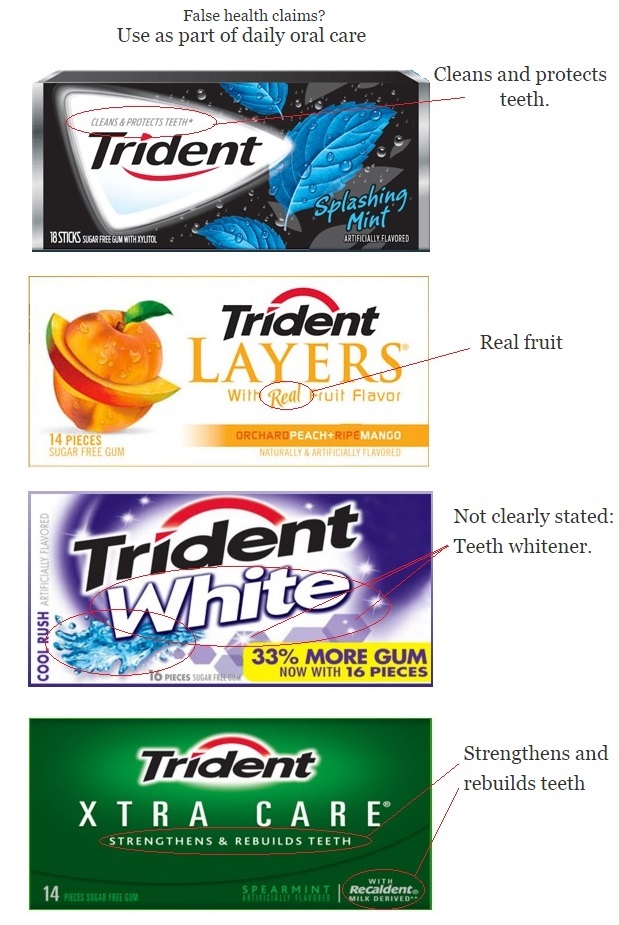Anatomy of a chewing gum.
Oral care or just another treat?
The USA sold 4.2 billion U.S. dollars worth of chewing gum in 2013.
Trident is the American favorite gum brand, so I went to their website to see what’s going on.
The first few things I’ve noticed are :
1) Where is the nutritional information about their gums? They seem so proud of their products and yet they don’t proudly share their ingredients list on their website.
2) Why are all their gums promoted as being part of a daily oral health care?
When did the transition from ‘pink sweet bubble‘ gum to ‘healthy fresh’ gum happen?
3) Are dentists really recommending these gums as being a good medical support for our teeth ?
Here are some snippets from Trident’s website.

Of course I visited mouthhhealthy.org because I wanted to see if the ADA (the American Dental Association) was truly backing up chewing gum as part of a daily oral health care.
And the answer is yes. This is what I found :

Ok… Of course I can get into the whole : can we even trust the ADA? Is $$$ involved? But this is too big of a question to tackle, so I’ll stick to the nutritional facts… that btw, I never found on Trident’s website.
So I found the nutrition information of these gums by myself and here is what you are being encouraged to put in your mouth on a daily basis :
All the ingredients that can be present in the gums are:
SORBITOL, GUM BASE, XYLITOL, GLYCERIN, NATURAL AND ARTIFICIAL FLAVORING, MANNITOL; LESS THAN 2% OF: ACESULFAME POTASSIUM, ASPARTAME, BHT (TO MAINTAIN FRESHNESS), SOY LECITHIN AND SUCRALOSE. PHENYLKETONURICS: CONTAINS PHENYLALANINE. RED 40 LAKE, BLUE 1,RED 40, YELLOW 5, YELLOW 5 LAKE, YELLOW 6 AND YELLOW 6 LAKE, RED 40 LAKE.
Oh nooo ! I have a headache just by looking at this list.
So is chewing gum bad for you?
Here is what I know and what I have found.
Sorbitol, mannitol and xylitol are manufactured sugar alcohols. (The sources are corncob, sugar cane, cornstarch etc.). Even if originally they come from a food source, the key word in the previous sentence is : manufactured. In this case for example there is a hydrogenating process to get these sugar alcohols.
FDA regulations permit sorbitol, mannitol and xylitol but they do warn that : “Excess consumption may have a laxative effect.” This means that if you tend to have an irritable digestive system, I would definitely avoid chewing gum with these sweeteners. Children tend to be even more sensitive to these sweeteners.
Note : xylitol is classified as : most probably cancerous by the Cancer Research Association of France. (ARTAC).
Gum Base : The exact composition of gum base seems to be a trade secret. They can be made of resins, waxes, emulsifiers, elastomers… etc. Who really knows..?
Glycerin : Also used in the production of soap. Declared safe. Some studies seem to think that glycerin could also have laxative effects and could increase gas, thirst, nausea and headaches.
Natural and artificial flavoring : I don’t like it when they write this. Was is it exactly ?
Acesulfame-potassium : One of the most disputed food additives. Some studies say that it is toxic and some say it’s ok. In these cases I personally prefer to avoid. I also noticed that some of the studies that declare acesulfame-potassium as being safe were studies done by the producer of Acesulfame-potassium! (SA Hoechst)
The Cancer Association ARTAC also classifies this additive as most probably cancerous.
Aspartame : Also one of the most disputed food additives. Side effects seem to be : deregulating the body weight and emotional disorders. ARTAC classifies this as certainly cancerous.
BHT : A lot of studies show that BHT is certainly cancerous. Some suggest that BHT increases allergies, blood cholesterol or could harm your liver (and many other side effects.).
I personally avoid everything that has BHT. (note : Bht is the one used in yoga matresses and other plastic items.)
Soy lecithin : This one seems to be ok. You have to really exaggerate its consumption to effect your appetite or to increase risks of excessive sweating.
Sucralose : not sure yet about this. According to the FDA sucralose is safe. Even though studies on animals have shown that sucralose can increase the size of the liver or the kidneys and that it could affect the immune system.
Anyway, I am going to stop here with the list because we got the point.
And the point is :
Gums like Trident, Orbit or Excel are a concentrate of food additives, intensively manufactured food and completely artificial chemicals.
Most of these components are shady and are highly disputed in the scientific world.
One is not even officially approved by the FDA and is added to food thanks to a petition and all the lobbyism behind it.
My conclusion :
These chewing gums should DEFINITELY NOT be promoted as a good daily practice for oral care.
An alternative : healthy chewing gum exists.
The best alternative would be to bring back the gum of my childhood ! And this was not a pink bubble gum !
I grew up in the Mediterranean region and my grandmother and aunts used to chew a gum that we called : Mastic.
This is simply a resin you obtain from trees that grow in the Mediterranean region.
The island of Chios in Greece has the most famous variety. The resine has been collected since ancient times and this practice is now part of the world heritage list of UNESCO (since 2014).
 Mastic is the resin that has been sun dried into brittle, translucent pieces. At first the flavor is bitter and then it releases this very nice pine or cedar-like flavor.
Mastic is the resin that has been sun dried into brittle, translucent pieces. At first the flavor is bitter and then it releases this very nice pine or cedar-like flavor.
As a kid I used to love this chewing gum because you were considered as a ‘master’ chewer if you were able to make a ‘tik’ noise at each chew.
Then the big marketing of western chewing gums hit us and we switched from this natural gum to a food-additive packed gum. (sigh).

Hope this helped,
All the best,
Sofia Abdelkafi Registered Nutritionist
![]()




























